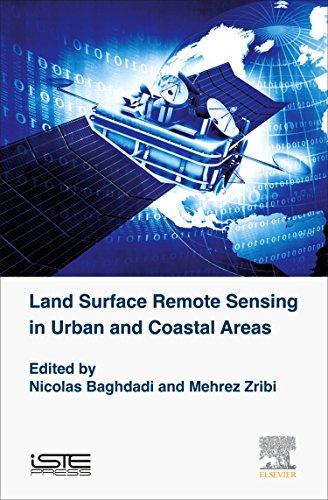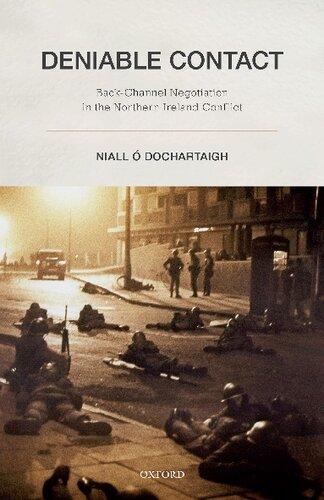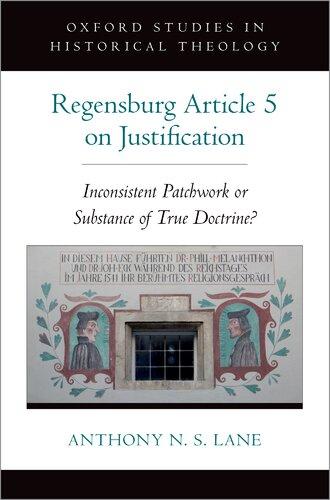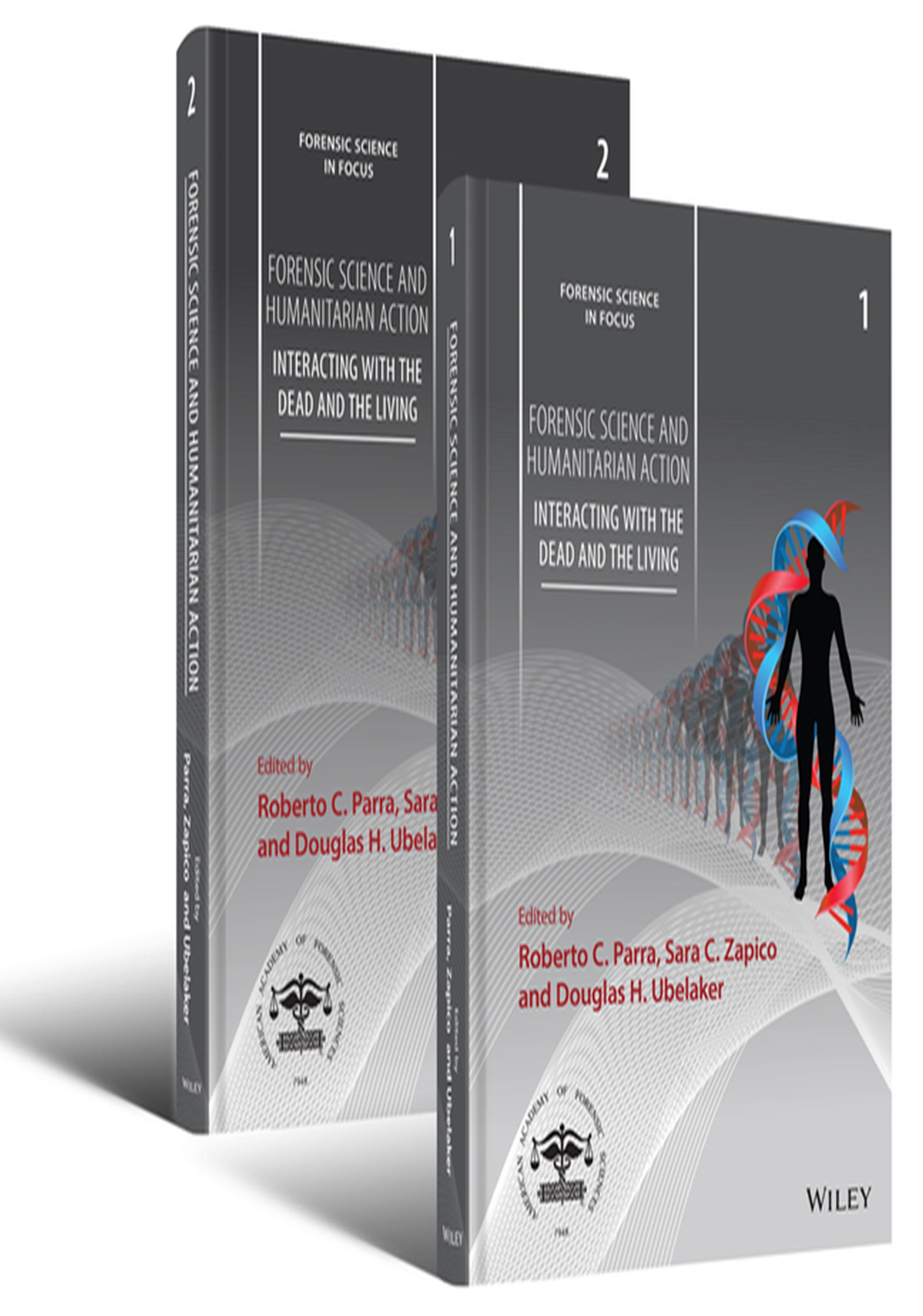Forensic Science and Humanitarian Action:
Interacting with the Dead and the Living
Volume 1
EDITED BY Roberto C. Parra
Human Rights Office of the High Commissioner (OHCHR), United Nations; and Bioarchaeology and Stable Isotope Research Laboratory, Vanderbilt University, Nashville, Tennessee, USA
Sara C. Zapico
Florida International University, International Forensic Research Institute, Miami, USA
Douglas H. Ubelaker
Smithsonian Institution, National Museum of Natural History, Washington, DC, USA
This edition first published 2020 © 2020 John Wiley & Sons Ltd
All rights reserved. No part of this publication may be reproduced, stored in a retrieval system, or transmitted, in any form or by any means, electronic, mechanical, photocopying, recording or otherwise, except as permitted by law. Advice on how to obtain permission to reuse material from this title is available at http://www.wiley.com/go/ permissions.
The right of Roberto C. Parra*, Sara C. Zapico and Douglas H. Ubelaker to be identified as the authors of the editorial material in this work has been asserted in accordance with law.
*The views expressed herein are those of the author and do not necessarily reflect the views of the United Nations.
Registered Offices
John Wiley & Sons, Inc., 111 River Street, Hoboken, NJ 07030, USA
John Wiley & Sons Ltd, The Atrium, Southern Gate, Chichester, West Sussex, PO19 8SQ, UK
Editorial Office
The Atrium, Southern Gate, Chichester, West Sussex, PO19 8SQ, UK
For details of our global editorial offices, customer services, and more information about Wiley products visit us at www.wiley.com.
Wiley also publishes its books in a variety of electronic formats and by print‐on‐demand. Some content that appears in standard print versions of this book may not be available in other formats.
Limit of Liability/Disclaimer of Warranty
MATLAB® is a trademark of The MathWorks, Inc. and is used with permission. The MathWorks does not warrant the accuracy of the text or exercises in this book. This work’s use or discussion of MATLAB® software or related products does not constitute endorsement or sponsorship by The MathWorks of a particular pedagogical approach or particular use of the MATLAB® software.
In view of ongoing research, equipment modifications, changes in governmental regulations, and the constant flow of information relating to the use of experimental reagents, equipment, and devices, the reader is urged to review and evaluate the information provided in the package insert or instructions for each chemical, piece of equipment, reagent, or device for, among other things, any changes in the instructions or indication of usage and for added warnings and precautions. While the publisher and authors have used their best efforts in preparing this work, they make no representations or warranties with respect to the accuracy or completeness of the contents of this work and specifically disclaim all warranties, including without limitation any implied warranties of merchantability or fitness for a particular purpose. No warranty may be created or extended by sales representatives, written sales materials or promotional statements for this work. The fact that an organization, website, or product is referred to in this work as a citation and/or potential source of further information does not mean that the publisher and authors endorse the information or services the organization, website, or product may provide or recommendations it may make. This work is sold with the understanding that the publisher is not engaged in rendering professional services. The advice and strategies contained herein may not be suitable for your situation. You should consult with a specialist where appropriate. Further, readers should be aware that websites listed in this work may have changed or disappeared between when this work was written and when it is read. Neither the publisher nor authors shall be liable for any loss of profit or any other commercial damages, including but not limited to special, incidental, consequential, or other damages.
Library of Congress Cataloging‐in‐Publication Data
Names: Parra, Roberto C., 1979– editor. | Zapico, Sara C., editor. | Ubelaker, Douglas H., editor.
Title: Forensic science and humanitarian action : interacting with the dead and the living / edited by Roberto C. Parra, Sara C. Zapico, Douglas H. Ubelaker.
Description: First edition. | Hoboken, NJ : John Wiley & Sons, Inc., 2020. | Series: Forensic science in focus | Includes bibliographical references and index.
Identifiers: LCCN 2019030283 (print) | LCCN 2019030284 (ebook) | ISBN 9781119481966 (cloth ; 2 vol. set) | ISBN 9781119481942 (adobe pdf) | ISBN 9781119482024 (epub)
Subjects: LCSH: Forensic sciences. | Forensic anthropology. | Dead–Identification. | Humanitarian assistance.
Classification: LCC HV8073 .F58355 2020 (print) | LCC HV8073 (ebook) | DDC 363.25–dc23
LC record available at https://lccn.loc.gov/2019030283
LC ebook record available at https://lccn.loc.gov/2019030284
Cover Design: Wiley
Cover Image: © Sandipkumar Patel/Getty Images; © Christos Georghiou/Shutterstock Set in 10.5/13.5pt Meridien by SPi Global, Pondicherry, India
In memory of:
María Isabel Chorobik de Mariani (Chicha), Mendoza, Argentina, 19 November 1923 – 20 August 2018.
Angelica Mendoza de Azcarsa (Mama Angelica), Ayacucho, Peru, 1 October 1929 – 28 August 2017.
We also dedicate this book to Enriqueta Estela Barnes de Carlotto, President of the association Abuelas de Plaza de Mayo (Argentina), and Adelina Garcia Mendoza, President of the Asociación Nacional de Familiares de Secuestrados, Detenidos y Desaparecidos del Perú (ANFASEP), and to all the members of those organisations:
… emblematic women to whom we pay tribute and dedicate this book. They used all their efforts to find them, saw and suffered the tragedy, the humanitarian need, and the need for truth. They were visionary and promoted the use of science in looking for them.
Contents
About the editors, xxv
About the contributors, xxvii
Foreword – Peter Maurer, lvii
Foreword – Susan M. Ballou, lix
Foreword – Oran Finegan, lxiii
Series preface, lxvii
Preface, lxix
Acknowledgements, lxxv
Section I History, theory, practice and legal foundation, 1
1 Using forensic science to care for the dead and search for the missing: In conversation with Morris Tidball‐Binz, 3 Morris Tidball‐Binz
Afterword, 20
Acknowledgement, 22 References, 23
2 The protection of the missing and the dead under international law, 25 Ximena Londoño Romanowsky and Marisela Silva Chau
2.1 Introduction, 25
2.2 The protection of the missing and the dead under international law, 26
2.2.1 The protection of the missing under international law, 26
2.2.2 The protection of the dead under international law, 28
2.3 The families at the center of the humanitarian action, 32
2.3.1 The needs of the families, 32
2.3.2 ICRC action in favor of the families, 33
2.4 Conclusion, 34 References, 34
3 Extraordinary deathwork: New developments in, and the social significance of, forensic humanitarian action, 37 Claire Moon
3.1 Introduction, 37
3.2 Field constitution: new developments, 37
3.3 (Extra-ordinary) deathwork, 42
3.4 Conclusions, 46 References, 47
4 Between darts and bullets: A bioarchaeological view on the study of human rights and IHL violations, 49
María del Carmen Vega Dulanto
4.1 Introduction, 49
4.2 What is violence?, 49
4.3 How do bioarchaeologists study violence?, 50
4.3.1 The skeletal data, 51
4.3.2 Interpreting violence, 52
4.3.3 Social theory, 54
4.4 A + B = violence?, 55
4.5 Bioarchaeological vs. clinical and forensic perspectives, 56 References, 58
5 Posthumous dignity and the importance in returning remains of the deceased, 67
Sian Cook
5.1 Introduction, 67
5.1.1 Conceptualizing posthumous dignity, 67
5.1.2 Assumptions for the existence of dignity after death, 70
5.2 Posthumous dignity, 71
5.2.1 Deconstructing posthumous dignity, 71
5.2.2 Duties of the living regarding the deceased, 72
5.3 The concept of moral injury, 72
5.4 The concept of human remains as a boundary object, 74
5.5 Theoretical framework regarding safeguarding dignity of the deceased, 74
5.6 The importance of returning remains of the deceased, 75
5.7 Conclusion, 76 References, 76
6 Unidentified deceased persons: Social life, social death and humanitarian action, 79
Roberto C. Parra, Élisabeth Anstett, Pierre Perich and Jane E. Buikstra
6.1 Introduction, 79
6.2 The social life of dead bodies, 81
6.2.1 Matter inside of place, 84
6.3 The social death of the dead, 86
6.4 Unidentified dead bodies and deposit sites, 89
6.5 Dignifying the life of the dead, 93
6.5.1 Rescue and burial as a humanitarian mechanism, 93
6.6 Conclusion, 95 Acknowledgement, 96 References, 96
7 A forensic perspective on the new disappeared: Migration revisited, 101
Jose Pablo Baraybar, Inés Caridi and Jill Stockwell
7.1 Introduction, 101
7.2 Framing the tragedy: Data challenges, 103
7.3 Framing the tragedy: The missing and the dead, 104
7.4 Tracing and identification, 105
7.5 Complex networks and migration, 107
7.5.1 Example 1: People related to a particular event/series of events, 107
7.5.2 Example 2: Inferring unknown information of individuals through the network, 108
7.5.3 Example 3: Tracing missing migrants, 109
7.6 A non‐body centred forensic response?, 111
7.7 Conclusion, 112
Acknowledgement, 114 References, 114
8 Iran: The impact of the beliefscape on the risk culture, resilience and disaster risk governance, 117 Michaela Ibrion
8.1 Introduction, 117
8.2 Risk culture, 118
8.3 Resilience, 118
8.4 Disaster risk governance, 119
8.5 Beliefscape in Iran, 119
8.5.1 Evil eyes, illness and death, 120
8.5.2 Death and funerary rituals, 121
8.5.3 Graves, cemeteries, dead and living people, 124
8.5.4 Washing the dead: technology and controversies, 124
8.5.5 Food offerings, the death passage rites and rituals and death commemorations, 125
8.5.6 Earthquake disasters and dead people, 125
8.5.7 Moharam (muharram) and the commemoration of pain and dramatic death of Imam Hussain, 127
8.5.8 Death, funeral ceremonies, controversies and three national figures of Iran: Reza Shah Pahlavi, Mohammad Mossadeq and Gholam Reza Takhti, 129
8.6 Discussions and concluding remarks, 132 References, 133
9 The search for the missing from a humanitarian approach as a Peruvian national policy, 135
Mónica Liliana Barriga Pérez
9.1 Introduction, 135
9.2 Peruvian scenario regarding the search for missing persons, 136
9.3 Progress made by the DGBPD, 139
9.4 Conclusion, 142
10 Humanitarian forensic action in the Marawi crisis, 143
Sarah Ellingham and Derek C. Benedix
10.1 Introduction, 143
10.2 The Philippine forensic response capacity, 144
10.2.1 The Management of the Dead and Missing (MDM) Cluster, 144
10.2.2 Forensic human identification in the Philippines, 145
10.3 The conflict in Mindanao and the Marawi crisis, 147
10.4 Forensic humanitarian response to the Marawi crisis, 148
10.4.1 Body recovery, 149
10.4.2 Logistical challenges for post‐mortem documentation and disposition of the dead, 149
10.4.3 Religious considerations, 150
10.4.4 Ante‐mortem data (AMD) collection, 151
10.5 Discussion, 152
Acknowledgements, 154 References, 154
Section II Forensic basic information to trace missing persons, 157
11 Integration of information on missing persons and unidentified human remains: Best practices, 159
Diana Emilce Ramírez Páez
11.1 Introduction, 159
11.2 The integration of information, 160
11.2.1 Conceptualization, 160
11.2.2 The information integration process, 161
11.3 Premises to take into account, 163
11.3.1 Ante‐mortem and post‐mortem information can be completed, 163
11.3.2 Collecting ante‐mortem and post‐mortem information is a specialized process, 164
11.3.3 All data must be cross‐checked, 164
11.3.4 The technical cross‐checking process is cyclical until all missing persons are located and found, 164
11.4 Best practices, 164
11.4.1 Normative, 165
11.4.2 Awareness of data quality, 165
11.4.3 Systematizing information, 165
11.4.4 Category agreement, 165
11.4.5 Homologation of variables, 166
11.4.6 Assignment of roles and/or responsibilities, 166
11.4.7 Selection of qualified staff, 166
11.4.8 Information system training, 167
11.4.9 Monitoring information and computer systems, 167
11.4.10 Information cross‐checking expert report, 167 Appendix: Colombian normative references, 168
12 Forensic archaeology and humanitarian context: Localization, recovery and documentation of human remains, 171 Flavio Estrada Moreno and Patricia Maita
12.1 Introduction, 171
12.2 Localization and recovery strategies, 172
12.3 Sites with human remains and their associated elements, 173
12.4 Recovery of human remains, 175
12.5 Recording human remains, 176
12.5.1 Body deposition, 176
12.5.2 Body position, 176
12.5.3 Orientation of the body, 177
12.6 Recording associated elements, 177
12.7 Disposal container, 178
12.8 Recording forensic deposits, 178
12.9 Evaluating relative chronology, 180
12.10 Conclusions and recommendations, 181 References, 181
13 Applications of physiological bases of aging to forensic science: New advances, 183
Sara C. Zapico, Douglas H. Ubelaker and Joe Adserias‐Garriga
13.1 Introduction, 183
13.2 Chemical methodologies, 184
13.2.1 Aspartic acid racemization, 184
13.2.2 Lead accumulation, 185
13.2.3 Collagen cross‐links, 186
13.2.4 Chemical composition of teeth, 186
13.2.5 Advanced glycation endproducts (AGEs), 187
13.3 Molecular biology methodologies, 188
13.3.1 Telomere shortening, 188
13.3.2 Mitochondrial DNA (mtDNA) mutations, 188
13.3.3 sjTREC rearrangements, 189
13.3.4 Epigenetic modifications, 190
13.4 Conclusion, 191 References, 191
14 Adult skeletal sex estimation and global standardization, 199
Heather M. Garvin and Alexandra R. Klales
14.1 Introduction, 199
14.2 Sexual size dimorphism, 200
14.3 Morphological traits, 201
14.4 Global standardization, 204 References, 206
15 Sexual dimorphism in juvenile skeletons and its real problem, 211
Flavio Estrada Moreno
15.1 Introduction, 211
15.2 Is it possible to estimate the sex of subadults based on morphological characteristics of the jaw and the ilium?, 212
15.3 From what age range is it possible to estimate sex in subadult skeletal remains? Skeletal growth, bone maturation and sex steroids, 213
15.4 What is the degree of precision and reliability of the visual criteria used to estimate sex in subadult skeletal remains? What criteria are applicable to forensic contexts?, 215
15.5 Comments and discussion, 216
15.6 Conclusions, 216 References, 217
16 Dental aging methods and population variation, 219
Joe Adserias‐Garriga and Joel Tejada
16.1 Introduction, 219
16.2 Dental age estimation: its application in forensic science, 221
16.3 Tooth developmental changes, 221
16.4 Dental age estimation methods using tooth development and eruption, 223
16.5 Post‐formation changes in dental tissues, 226
16.6 Methods of dental age estimation using tooth post‐formation changes, 227
16.7 Dental age estimation methods and their application in forensic casework, 229 References, 230
17 Age assessment in unaccompanied minors: A review, 235
José Luis Prieto
17.1 Introduction, 235
17.2 Age assessment methods in unaccompanied minors, 236
17.3 Age definition: What does age mean?, 240
17.4 Choosing a suitable method, 241
17.5 Forensic age assessment medical methods, 242
17.5.1 Interview and medical history, 243
17.5.2 Physical examination, 243
17.5.3 Dental development, 244
17.5.4 Skeletal maturation, 247
17.6 Final estimation and report, 250
17.7 Conclusions, 251 References, 251
18 Forensic complex scenarios and technological innovation: Brief case report from Colombia, 257
Ginna P. Camacho Cortés, Luz Adriana Pérez and Diana Arango Gómez
18.1 Introduction, 257
18.2 Case 1: Predictive spatial and statistical modeling (MESP) as a tool to support the search for missing persons in the department of Casanare, 258
18.3 Case 2: Modeling the estimated universe of persons reported missing: The cases of Casanare and Norte de Santander, 262
18.4 Case 3: Proposal for the retrospective and integrated analysis of environmental and contextual elements for a differential forensic genetic approach, 264
18.5 Case 4: Tools for the forensic analysis of cases of alleged extrajudicial executions, 267 References, 270
Section III Stable isotope forensics and the search for missing persons, 273
19 The role of stable isotope analysis in forensic anthropology, 275 Douglas H. Ubelaker and Caroline Francescutti
19.1 Introduction, 275
19.2 Trace element analysis, 276
19.3 Diet and isotopic analysis, 277
19.4 Variation within individuals, 278
19.4.1 Quality control, 278
19.4.2 Residence, 279
19.5 Summary, 280 References, 280
20 Basic principles of stable isotope analysis in humanitarian forensic science, 285
Lesley A. Chesson, Wolfram Meier‐Augenstein, Gregory E. Berg, Clement P. Bataille, Eric J. Bartelink and Michael P. Richards
20.1 Introduction, 285
20.2 Background on isotopes, 286
20.3 Isotopes in human tissue, 288
20.4 Longer‐term “memory” tissues: Bone and teeth, 292
20.4.1 Oxygen isotopic composition of bioapatite, 292
20.4.2 Carbon isotopic composition of bioapatite and collagen, 294
20.4.3 Caveats for the oxygen isotope analysis of bone and teeth, 296
20.5 Shorter‐term “memory” tissues: Hair and nail, 297
20.5.1 Hydrogen isotopic composition of hair and nail, 298
20.5.2 Caveats for the hydrogen isotope analysis of hair and nail, 299
20.5.3 Carbon and nitrogen isotopic compositions of hair and nail, 300
20.5.4 Caveats for the carbon and nitrogen isotope analysis of hair and nail, 301
20.5.5 Strontium and lead isotopic compositions of human tissue, 302
20.6 Conclusion, 303 References, 303
21 Andean isoscapes: Creating and testing oxygen isoscape models to aid in the identification of missing persons in Peru, 311 James Zimmer‐Dauphinee, Beth K. Scaffidi and Tiffiny A. Tung
21.1 Introduction, 311
21.1.1 Stable oxygen isotope values in dentition, 312
21.1.2 Stable oxygen isotopes and the landscape, 313
21.2 Materials and methods, 314
21.2.1 Description of the datasets, 314
21.2.2 Methods, 317
21.3 Results, 318
21.3.1 Overview description of the stable oxygen isotope data from surface water, 318
21.3.2 Ordinary kriging model, 320
21.3.3 Multiple linear regression model, 322
21.3.4 Regression kriging model, 322
21.3.5 Testing the model with archaeological samples, 324
21.4 Discussion, 324
21.4.1 Predicting source of water samples vs. archaeological human samples, 325
Acknowledgements, 327 References, 327
22 The period of violence in Peru (1980–2000): Applying isotope analysis and isoscapes in forensic cases of the unidentified deceased, 331
Martha R. Palma, Tiffiny A. Tung, Lucio A. Condori and Roberto C. Parra
22.1 Introduction, 331
22.2 The Peruvian Conflict and the government response, 332
22.3 The search for missing persons: “Families remain walking”, 334
22.4 Applying new isotopic techniques to aid in identifying victims’ bodies in Peru, 335
22.4.1 Stable oxygen isotopes and strontium isotopes, 336
22.4.2 Stable carbon and nitrogen isotopes, 338
22.5 Integrating traditional and non‐traditional methods to identify missing persons in Peru, 339
22.6 Conclusions, 341 References, 341
23 Utility of stable isotope ratios of tap water and human hair in determining region of origin in Central and Southern Mexico: Modeling relationships between δ2H and δ18O isotope inputs in modern Mexican hair, 345
Chelsey Juarez, Robin Ramey, David T. Flaherty and Belinda S. Akpa
23.1 Introduction, 345
23.2 Water stress in Mexico, 346
23.3 Tuning parameters in mathematical models used for provenance analysis, 348
23.4 Extension to analysis of hair isotopes in the absence of paired water samples, 348
23.5 Materials and methods, 349
23.5.1 Isotope mapping procedure, 352
23.5.2 Analysis and discussion, 356
23.6 Estimation of credible parameter values by approximate Bayesian computation, 359
23.7 Results obtained using the established US supermarket diet, 360
23.8 Results achieved by estimating international diet, drinking water, and regional diet isotopes, 361
23.9 Conclusions, 363 References, 364
24 Multi‐isotope approaches for region‐of‐origin predictions of undocumented border crossers from the US–Mexico border: Biocultural perspectives on diet and travel history, 369
Eric J. Bartelink, Lesley A. Chesson, Brett J. Tipple, Sarah Hall and Robyn T. Kramer
24.1 Introduction, 369
24.2 SIA as an investigative tool for undocumented border crossers, 371
24.2.1 Assumptions of SIA for provenancing studies, 371
24.2.2 Bio‐elements and geo‐elements used for geolocation, 372
24.3 Samples and analytical methods, 373
24.4 Results, 375
24.5 Case studies, 377
24.6 Summary and future research directions, 381 Acknowledgements, 382 References, 382
25 Spatial distribution of stable isotope values of human hair: Tools for region‐of‐origin and travel history assignment, 385
Luciano O. Valenzuela, Lesley A. Chesson, Gabriel Bowen, Thure E. Cerling and James R. Ehleringer
25.1 Introduction, 385
25.2 Why hair?, 386
25.3 Methods, 388
25.4 How is isotopic information incorporated into hair?, 388
25.4.1 Carbon, 389
25.4.2 Nitrogen, 389
25.4.3 Sulfur, 390
25.4.4 Body water, 390
25.4.5 Oxygen, 391
25.4.6 Hydrogen, 392
25.4.7 Integrated signal, 392
25.5 Geographical and population patterns of δ13C, δ15N and δ34S values, 393
25.5.1 From continents to cities, 395
25.5.2 From cities to individuals, 396
25.6 Geographical patterns of δ18O and δ2H values, 397
25.7 Individual deviations from expected patterns, 400
25.8 Travel history, 401
25.9 Solved forensic investigations, 403
25.10 Final considerations, 403
25.10.1 How fixed are the geographical patterns of δ13C, δ15N and δ34S values?, 403
25.10.2 Seasonal stability of drinking water δ18O and δ2H values, 404
25.10.3 Bundling and analysing very long hair, 405
25.10.4 Fingernails vs. hair, 405
25.11 Conclusions, 405 References, 406
26 Applicability of stable isotope analysis to the Colombian human identification crisis, 411
Daniel Castellanos Gutiérrez, Elizabeth A. DiGangi and Jonathan D. Bethard
26.1 Introduction, 411
26.2 Stable isotopes in human provenance, 412
26.3 Human tissues appropriate for isotope studies, 415
26.4 Colombian geography, 416
26.5 The Colombian conflict and the missing, 418
26.6 Stable isotopes and identification in Colombia: Initial research efforts, 418
26.7 Final remarks, 420 Acknowledgements, 422 References, 422
27 Application of stable isotopes and geostatistics to infer region of geographical origin for deceased undocumented Latin American migrants, 425 Robyn T. Kramer, Eric J. Bartelink, Nicholas P. Herrmann, Clement P. Bataille and Kate Spradley
27.1 Introduction, 425
27.2 Stable isotopes, provenancing studies, and isoscapes, 426
27.2.1 Strontium and geological mapping, 427
27.2.2 Oxygen isotopes and precipitation, 429
27.2.3 Dual‐isotope maximum likelihood estimation assignment model, 430
27.3 Materials and methods, 431
27.3.1 Sample, 431
27.3.2 Isotope sample preparation, 432
27.3.3 87Sr/86Sr isoscape, 433
27.3.4 δ18O isoscape, 433
27.4 Results, 433
27.4.1 OpID‐0383, 433
27.4.2 OpID‐0608, 435
27.5 Discussion and conclusions, 435 References, 437
28 Tracking geographical patterns of contemporary human diet in Brazil using stable isotopes of nail keratin, 441
Gabriela Bielefeld Nardoto, João Paulo Sena‐Souza, Lesley A. Chesson and Luiz
Antonio Martinelli
28.1 Introduction, 441
28.2 Isotope procedures, 443
28.3 Scientific basis for isotope data interpretation, 444
28.4 Geographic peculiarities in stable isotope ratios of fingernails, 446
28.4.1 Brazilian Amazon, 446
28.4.2 Northeastern Brazil, 447
28.4.3 Central Brazil, 447
28.5 Brazilian isoscapes, 448
28.5.1 Primary source isoscapes, 448
28.5.2 Source‐consumer isoscapes, 451
28.6 Final considerations, 452 References, 453
Section IV DNA analysis and the forensic identification process, 457
29 Phenotypic markers for forensic purposes, 459
Ana Freire‐Aradas, Christopher Phillips, Victoria Lareu Huidobro and Ángel Carracedo
29.1 Introduction, 459
29.2 Biogeographical origin, 459
29.3 Externally visible characteristics, 463
29.3.1 Eye colour prediction, 463
29.3.2 Hair colour prediction, 464
29.3.3 Skin colour prediction, 465
29.3.4 Additional externally visible characteristics, 465
29.4 Individual age, 466
Acknowledgements, 469 References, 469
30 Genetic structure and kinship analysis from the Peruvian Andean area: Limitations and recommendation for DNA identification of missing persons, 473
Gian Carlo Iannacone and Roberto C. Parra
30.1 Introduction, 473
30.2 Previous factors for matching success in the context of genetic structure, 475
30.3 Substructure and matching between genetic profile databases (Factor 3), 477
30.4 Origin of Peruvian population and the genetic structure (Factor 3), 479
30.5 Admixture of Peruvian population and the genetic structure (Factor 3), 483
30.6 Matching of genetic profiles in the context of genetic similarity (Factor 3), 485 References, 487
31 Short tandem repeat markers applied to the identification of human remains, 491
William Goodwin, Hassain M.H. Alsafiah and Ali A.H. Al‐Janabi
31.1 Introduction, 491
31.2 Selection of genetic markers, 491
31.3 STR loci and kinship testing, 495
31.4 The strength of DNA evidence, 495
31.5 Limitations of STR loci for the identification of human remains, 498
31.6 Massive parallel sequencing (MPS), 501
31.7 Incorporating DNA analysis into the identification process, 504
31.8 Conclusions, 506 References, 506
32 Genetics without non‐genetic data: Forensic difficulties in correct identification – the Colombian experience, 509
Manuel Paredes López
32.1 Genetics in the identification of bodies associated with the violation of human rights and international humanitarian law: A humanitarian challenge, 509
32.2 The integration of genetics into traditional forensic disciplines specialized in the identification of human remains, 510
32.3 Forensic genetics in the Colombian armed conflict, 512
32.4 Interdisciplinary forensic work is a priority, 513
32.5 Tasks of the forensic geneticist within the interdisciplinary identification team, 514
32.6 Effects of the overvaluation of the genetic result, 516
32.6.1 False negatives: non‐existent exclusion, 516
32.6.2 False positives and spurious matches in databases, 518
32.7 Conclusion, 519
References, 520
33 Is DNA always the answer?, 521
Caroline Bennett
33.1 Introduction, 521
33.2 The magic of DNA, 522
33.3 DNA as truth, identity and relatedness, 523
33.4 Justice and healing, 525
33.5 Dealing with bodies, 527
33.6 The politics of identification, 529
33.7 Conclusion, 531 References, 532
Section V Identifying deceased and finding missing persons, 535
34 Migrant deaths along the Texas/Mexico border: A collaborative approach to forensic identification of human remains, 537
Kate Spradley and Timothy P. Gocha
34.1 Introduction, 537
34.2 Background, 538
34.2.1 Lack of humanitarian forensic action, 538
34.2.2 Operation Identification (OpID) and the Forensic Border Coalition (FBC), 540
34.3 Case studies, 541
34.3.1 Case 0387, 541
34.3.2 Case 0383, 543
34.3.3 Hugo Escobar Rodriguez, 544
34.4 Discussion, 546 References, 547
35 The Argentine experience in forensic identification of human remains, 549
Mercedes Salado Puerto, Laura Catelli, Carola Romanini, Magdalena Romero and Carlos María Vullo
35.1 Introduction, 549
35.2 Methods and challenges in applying forensic genetics, 551
35.3 Databases, data comparisons and reconciliation, 554
35.4 Conclusions, 556 References, 558
36 The approach to unidentified dead migrants in Italy, 559 Cristina Cattaneo, Debora Mazzarelli, Lara Olivieri, Danilo De Angelis, Annalisa Cappella, Albarita Vitale, Giulia Caccia, Vittorio Piscitelli and Agata Iadicicco
36.1 Introduction, 559
36.1.1 The paradox of the largest mass disaster of the past century, 559
36.1.2 The Italian perspective, 561
36.2 The experimental Italian strategy, 565
36.2.1 Pilot Study 1: AM data collection, 565
36.2.2 Pilot Study 2: PM data collection, 566
36.2.3 Working towards a national approach for the issue of dead migrants, 567
36.3 Conclusion, 567
Acknowledgements, 569 References, 569
37 Identification of human skeletal remains at the Federal Bureau of Investigation (FBI) Laboratory, 571
Angi M. Christensen, Ann D. Fasano, Richard B. Marx, John E.B. Stewart, Lisa G. Bailey and Richard M. Thomas
37.1 Introduction, 571
37.2 Search and recovery – FBI Evidence Response Teams, 572
37.3 Forensic anthropology, 576
37.4 DNA analysis, 581
37.5 Facial approximation, 584
37.6 Additional efforts, 590
37.7 Conclusion, 590 References, 591
38 Forensic human identification: An Australian perspective, 593 Soren Blau
38.1 Introduction, 593
38.2 Identification contexts, 593
38.2.1 Long‐term missing persons, 593
38.2.2 Individuals missing following war, 594
38.2.3 Disaster victim identification, 595
38.2.4 Historical figures, 596
38.3 Ante‐ and post‐mortem data, 596
38.3.1 Fingerprint records, 597
38.3.2 Dental records, 597
38.3.3 DNA information, 597
38.4 Forensic anthropology in Australia, 599
38.5 The process of identification in coronial casework, 600
38.6 Research, 601
38.7 Conclusion, 602
Acknowledgements, 602 References, 602
39 Forensic identification of human remains in Cyprus: The humanitarian work of the Committee on Missing Persons in Cyprus (CMP), 609
Gülbanu K. Zorba, Theodora Eleftheriou, Istenç Engin, Sophia Hartsioti and Christiana Zenonos
39.1 Origins and mandate of the CMP, 609
39.2 The project on the exhumation, identification and return of remains of missing persons, 610
39.3 Investigations on missing persons cases, 611
39.4 Sources of information and challenges, 611
39.5 Locating human remains, 612
39.6 Search for and recovery of remains, 613
39.7 Analysis at the CMP Anthropological Laboratory (CAL), 614
39.8 Challenging cases, 615
39.9 Sampling strategy, 617
39.10 The role of DNA analysis, 617
39.11 Collection of family reference samples, 618
39.12 DNA analysis and the identification process, 618
39.13 Reconciliation of information and identification: Challenges and approach, 619
39.14 Notification of identification and return of remains, 621
39.15 Conclusion, 621
Acknowledgements, 622
References, 623
40 Forensic human identification during a humanitarian crisis in Guatemala: the deadly eruption of Volcán de Fuego, 625
Daniel Jiménez
40.1 Introduction, 625
40.2 The context of violence in Guatemala, 626
40.3 The forensic anthropological analysis in medico‐legal investigation, 627
40.4 The Volcán de Fuego case: Paradigmatic event in Guatemala, 629
40.5 Conclusions, 632
Acknowledgements, 633
References, 633
41 Peruvian forensic experience in the search for missing persons and the identification of human remains: History, limitations and future challenges, 635
Roberto C. Parra, Martha R. Palma, Oswaldo Calcina, Joel Tejada, Lucio A. Condori and Jose Pablo Baraybar
41.1 Introduction, 635
41.2 The development of anthropological–forensic investigations and the search for missing persons in Peru, 636
41.3 Complexity and forensic limitations of the Peruvian case and the expectations of the relatives, 639
41.4 Future challenges, 648 Acknowledgements, 651 References, 651
42 Forensic identification of human remains in Uruguay, 653
Alicia Lusiardo, Ximena Salvo Eulacio, Aníbal Gustavo Casanova, Natalia Azziz, Rodrigo Bongiovanni, Matías López and Sofía Rodríguez
42.1 Introduction, 653
42.2 Forensic identification of human remains in Uruguay, 654
42.3 Roberto Gomensoro Josman case, 655
42.4 Olivar Sena case, 656
42.5 María Claudia García case, 657
42.6 Jonathan Viera case, 658
42.7 Recommendations, 659 References, 660
43 Forensic analysis of the unidentified dead in Costa Rica from 2000 to the present, 663
Georgina Pacheco‐Revilla and Derek Congram
43.1 Introduction, 663
43.2 Violence in Central and South America, 663
43.3 A complicating factor: Regional migration, 665
43.3.1 Case Study 1, 666
43.3.2 Case Study 2, 671
43.4 Conclusions, 676 References, 677
44 Identifying the unknown and the undocumented: The Johannesburg (South Africa) experience, 681
Desiré M. Brits, Maryna Steyn and Candice Hansmeyer
44.1 Introduction, 681
44.2 Forensic pathology services, 683
44.3 Forensic anthropology, 686
44.4 Discussion and conclusion, 689 Acknowledgements, 691 References, 691
45 The Colombian experience in forensic human identification, 693
Jairo Vivas Díaz and Claudia Vega Urueña
45.1 Introduction, 693
45.2 Evolution of the forensic human identification process in Colombia, 694
45.3 Other activities developed for human identification in the country, 698
45.3.1 Cross‐checking or comparison of information for identification purposes, 698
45.3.2 Forensic intervention of cemeteries, 699
45.4 Cold case: New forensic approach to the Palace of Justice case, 700
45.5 Recent challenges, 701 References, 702
46 The Chilean experience in forensic identification of human remains, 703 Marisol Intriago Leiva, Viviana Uribe Tamblay and Claudia Garrido Varas
46.1 Origins of the legal medical service, 703
46.2 September 1973 and the role of the Servicio Médico Legal (SML), 705
46.3 Family members: Search, justice, memory…, 706
46.4 The 1990–2006 transition to democracy: Family members and the continuous search for the detained, disappeared and executed, 710
46.5 Identifications via genetics, 712
46.6 Comments, 714
Section VI Conclusions, 715
47 Humanitarian action: New approaches from forensic science, 717 Douglas H. Ubelaker, Sara C. Zapico and Roberto C. Parra
47.1 Introduction, 717
47.2 History, 718
47.3 Theoretical foundation, 719
47.4 The legal and cultural arena, 719
47.5 Regional applications, 720
47.6 Capacity‐building, 720
47.7 Trauma assessment, 721
47.8 Technology, 721
47.9 Expanding areas of application, 722
47.10 Summary, 722 References, 723 Index, 727













